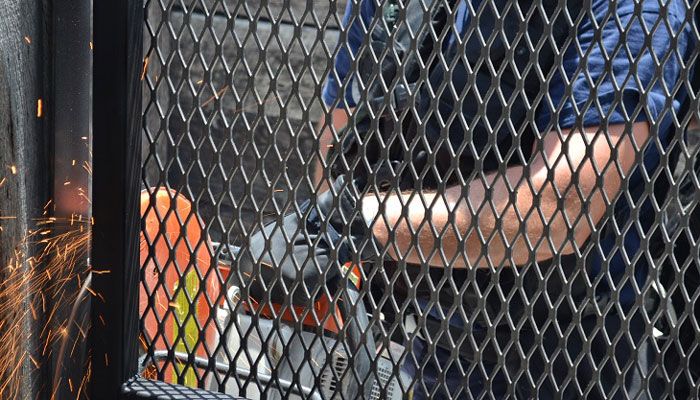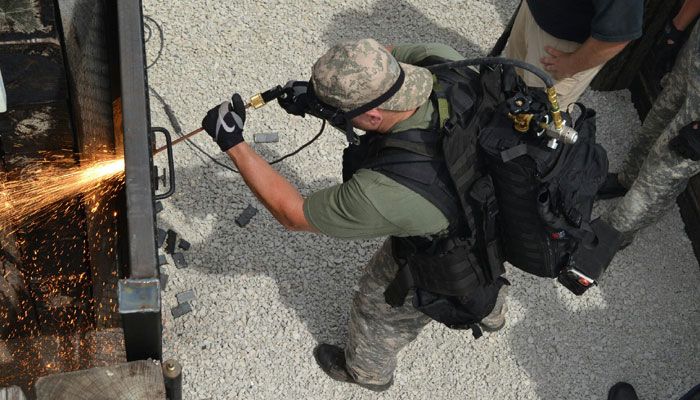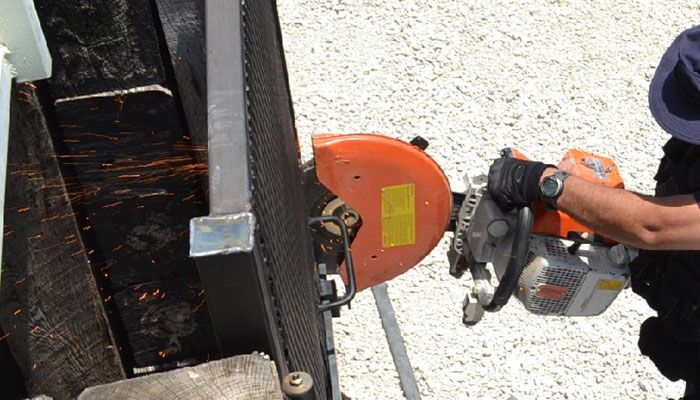By Mike Cantrell, P1 Contributor
Rams and hooligan tools are a must for any tactical breacher, but once you walk into a correctional facility, torches and saws are the go-to tools for a correctional breacher. For years Correctional Emergency Response Teams have known that getting through hardened prison structures requires mechanical breaching tools that are often more of a back-up or the last option in the residential breaching world.
First, let’s take a look at the rescue saw. This piece of equipment goes by many names: gas cut-off saw, chop saw, or demolition/rescue saw. All names refer to a portable saw that looks very much like a chainsaw except for the giant round blade on the end. Weighing around 20 to 25 pounds with a 12 to 16 inch circular blade, these workhorses can handle most of the materials thrown at them. Pair your saw with a diamond-edged blade to defeat concrete, steel, padlocks, hinges, PVC, Lexan, chain link and roofing quickly and efficiently.
 A quality diamond tipped blade paired with a rescue saw makes quick work of most materials. (Photo/Fred Koss)
A quality diamond tipped blade paired with a rescue saw makes quick work of most materials. (Photo/Fred Koss)
The rescue saw will accept many different types of blades, but all blades are not made the same. I often see abrasive blades utilized, but one twist while cutting chain link and you will have pieces of blade flying dangerously in the air. Buy a good blade; this will give you hours of training time with no worry about replacing the blade each time. The Broco Diamond Ripper is my favorite all-around blade for breaching, but there are a variety of blades on the market and with hundreds or even thousands of cuts per blade, you can increase the hands on time for each member of your CERT.
Second, let’s review the exothermic torch, originally developed for industrial uses and later for use in underwater demolition. The exothermic torch has become the mainstay of many military, correctional and residential breachers. Able to cut through metal like butter, the exothermic torch provides a portable and quick way to defeat some of the toughest barricades.
 The portability of the Broco Tactical Cutting Torch System is what makes it a favorite of correctional bleachers. (Photo/Fred Koss)
The portability of the Broco Tactical Cutting Torch System is what makes it a favorite of correctional bleachers. (Photo/Fred Koss)
The exothermic torch requires three things to operate:
- Oxygen (supplied by a portable 02 bottle)
- Fuel (carbon/steel cutting rods)
- Heat (provided by electrical current, e.g. 12 volt battery)
No mystery here about how the exothermic works, this combination is the same combustion triangle you were taught about in school. Simply, an exothermic (exo = external and thermic = thermal or heat) reaction is when more energy has been released than was needed initially to start and maintain the reaction. In other words, the battery is enough to start the chemical reaction that eventually is releasing 10,000 degrees of excess heat. This simple structure allows the portability and power needed to tackle the heaviest or most remote jobs in a correctional setting.
 Correctional breachers rely on the rescue saw for its ability to tackle many different materials. (Photo/Fred Koss)
Correctional breachers rely on the rescue saw for its ability to tackle many different materials. (Photo/Fred Koss)
The ArcAir Slice is a popular model for its portability, but the Broco Tactical Cutting Torch System was built with the tactical or correctional breacher in mind. The Broco Tactical Torch is self-contained within a Molle lightweight backpack that can be thrown on your shoulders and packed easily to the crisis site for immediate results.
 (Photo/Fred Koss)
(Photo/Fred Koss)
And don’t forget about training. Having an exothermic torch or rescue saw in the armory is not enough. Your CERT needs practice and training to know how to operate these tools when the time comes. Team up!











